An Analysis of Medical Devices and the Internet of Things: Risks
VerifiedAdded on 2020/03/01
|5
|1036
|104
Report
AI Summary
This report examines the integration of the Internet of Things (IoT) into medical devices, highlighting the benefits and risks. It identifies key threats, including the lack of built-in security, vulnerabilities arising from diverse device sources, network glitches in standalone devices, and risks associated with remote monitoring technologies. The report emphasizes the need for robust network security, recommending security scanning, the development of secure medical devices, and avoidance of third-party security components. The report concludes by advocating for collaboration among suppliers, manufacturers, and providers to create a safe and secure environment for data sharing and feedback within the healthcare industry. The paper also suggests countermeasures to mitigate these risks.
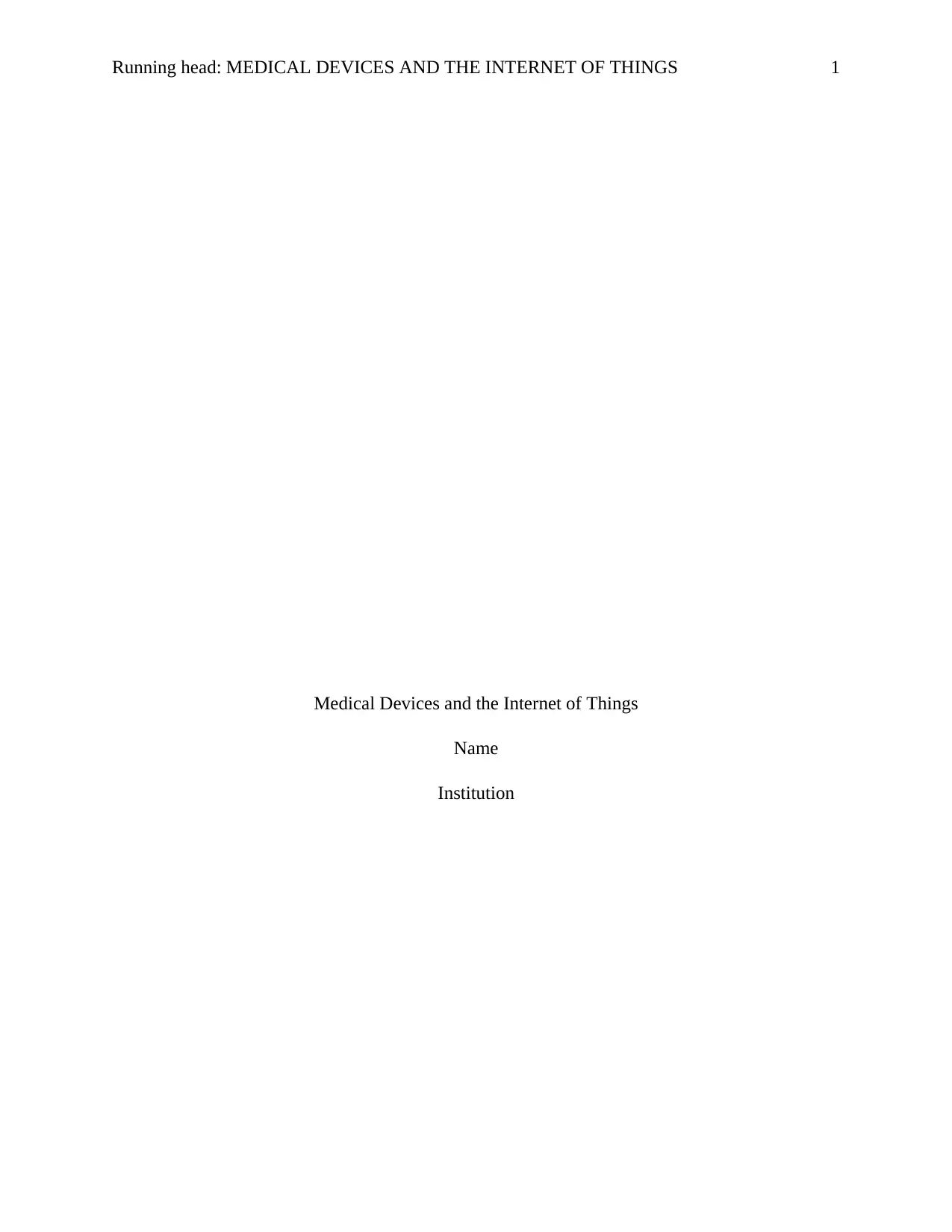
Running head: MEDICAL DEVICES AND THE INTERNET OF THINGS 1
Medical Devices and the Internet of Things
Name
Institution
Medical Devices and the Internet of Things
Name
Institution
Paraphrase This Document
Need a fresh take? Get an instant paraphrase of this document with our AI Paraphraser
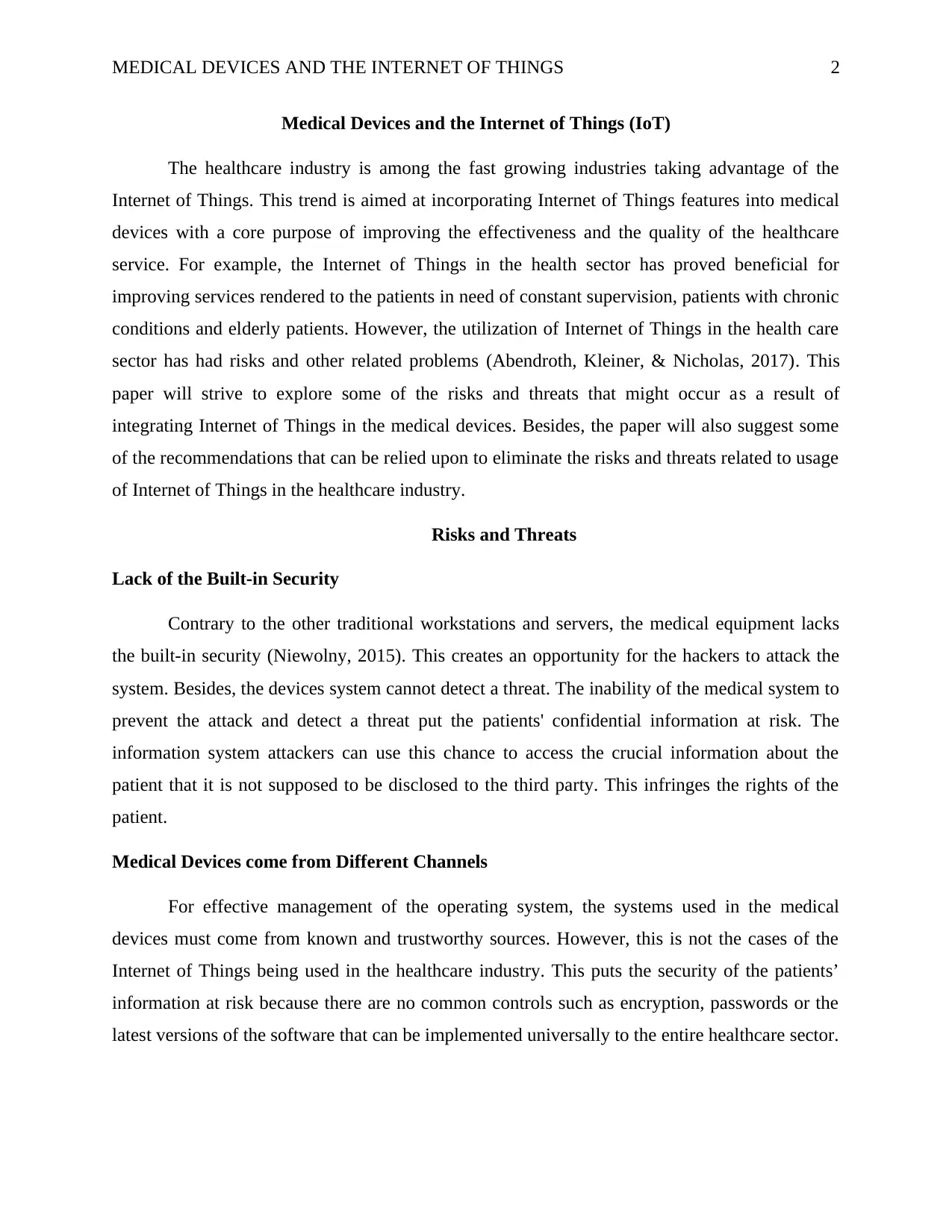
MEDICAL DEVICES AND THE INTERNET OF THINGS 2
Medical Devices and the Internet of Things (IoT)
The healthcare industry is among the fast growing industries taking advantage of the
Internet of Things. This trend is aimed at incorporating Internet of Things features into medical
devices with a core purpose of improving the effectiveness and the quality of the healthcare
service. For example, the Internet of Things in the health sector has proved beneficial for
improving services rendered to the patients in need of constant supervision, patients with chronic
conditions and elderly patients. However, the utilization of Internet of Things in the health care
sector has had risks and other related problems (Abendroth, Kleiner, & Nicholas, 2017). This
paper will strive to explore some of the risks and threats that might occur as a result of
integrating Internet of Things in the medical devices. Besides, the paper will also suggest some
of the recommendations that can be relied upon to eliminate the risks and threats related to usage
of Internet of Things in the healthcare industry.
Risks and Threats
Lack of the Built-in Security
Contrary to the other traditional workstations and servers, the medical equipment lacks
the built-in security (Niewolny, 2015). This creates an opportunity for the hackers to attack the
system. Besides, the devices system cannot detect a threat. The inability of the medical system to
prevent the attack and detect a threat put the patients' confidential information at risk. The
information system attackers can use this chance to access the crucial information about the
patient that it is not supposed to be disclosed to the third party. This infringes the rights of the
patient.
Medical Devices come from Different Channels
For effective management of the operating system, the systems used in the medical
devices must come from known and trustworthy sources. However, this is not the cases of the
Internet of Things being used in the healthcare industry. This puts the security of the patients’
information at risk because there are no common controls such as encryption, passwords or the
latest versions of the software that can be implemented universally to the entire healthcare sector.
Medical Devices and the Internet of Things (IoT)
The healthcare industry is among the fast growing industries taking advantage of the
Internet of Things. This trend is aimed at incorporating Internet of Things features into medical
devices with a core purpose of improving the effectiveness and the quality of the healthcare
service. For example, the Internet of Things in the health sector has proved beneficial for
improving services rendered to the patients in need of constant supervision, patients with chronic
conditions and elderly patients. However, the utilization of Internet of Things in the health care
sector has had risks and other related problems (Abendroth, Kleiner, & Nicholas, 2017). This
paper will strive to explore some of the risks and threats that might occur as a result of
integrating Internet of Things in the medical devices. Besides, the paper will also suggest some
of the recommendations that can be relied upon to eliminate the risks and threats related to usage
of Internet of Things in the healthcare industry.
Risks and Threats
Lack of the Built-in Security
Contrary to the other traditional workstations and servers, the medical equipment lacks
the built-in security (Niewolny, 2015). This creates an opportunity for the hackers to attack the
system. Besides, the devices system cannot detect a threat. The inability of the medical system to
prevent the attack and detect a threat put the patients' confidential information at risk. The
information system attackers can use this chance to access the crucial information about the
patient that it is not supposed to be disclosed to the third party. This infringes the rights of the
patient.
Medical Devices come from Different Channels
For effective management of the operating system, the systems used in the medical
devices must come from known and trustworthy sources. However, this is not the cases of the
Internet of Things being used in the healthcare industry. This puts the security of the patients’
information at risk because there are no common controls such as encryption, passwords or the
latest versions of the software that can be implemented universally to the entire healthcare sector.
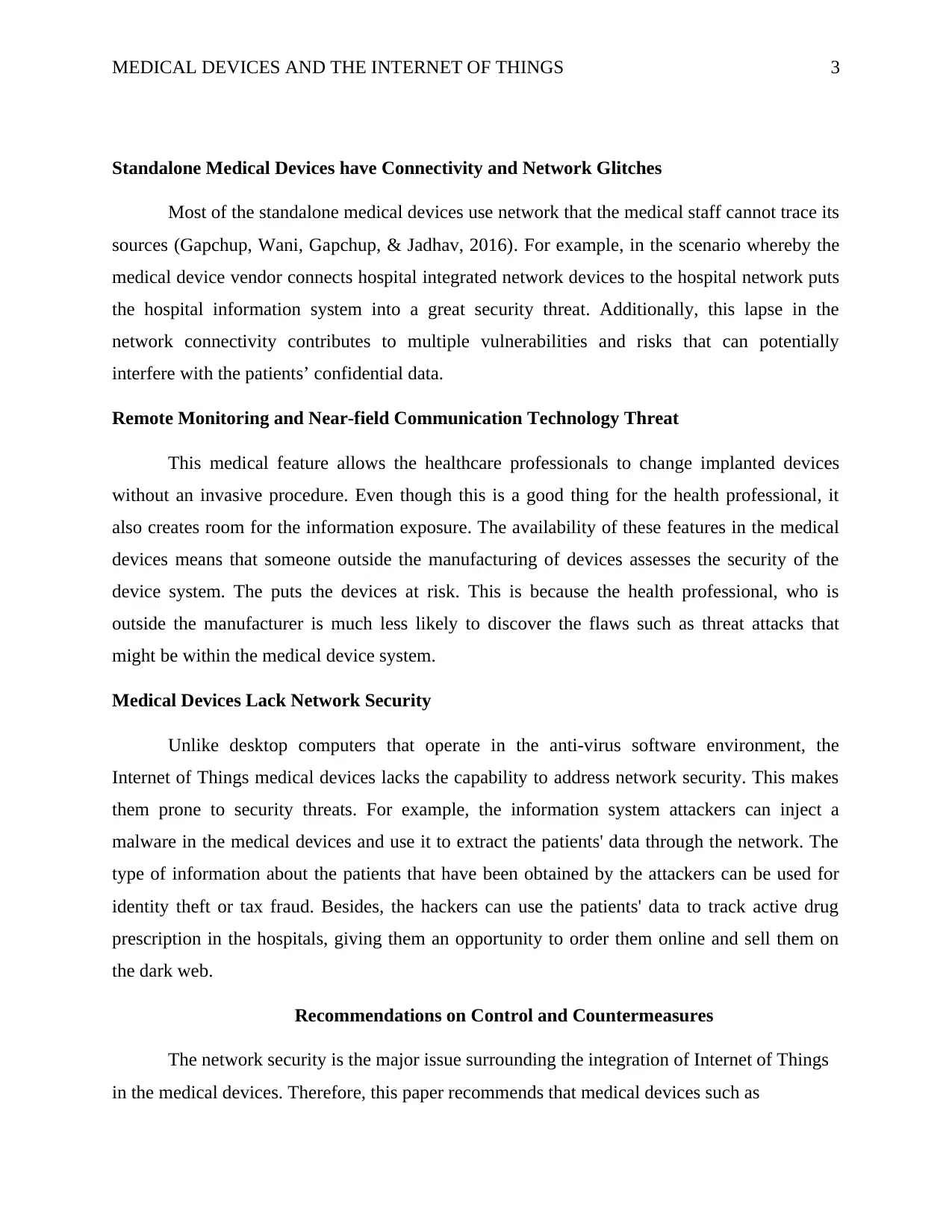
MEDICAL DEVICES AND THE INTERNET OF THINGS 3
Standalone Medical Devices have Connectivity and Network Glitches
Most of the standalone medical devices use network that the medical staff cannot trace its
sources (Gapchup, Wani, Gapchup, & Jadhav, 2016). For example, in the scenario whereby the
medical device vendor connects hospital integrated network devices to the hospital network puts
the hospital information system into a great security threat. Additionally, this lapse in the
network connectivity contributes to multiple vulnerabilities and risks that can potentially
interfere with the patients’ confidential data.
Remote Monitoring and Near-field Communication Technology Threat
This medical feature allows the healthcare professionals to change implanted devices
without an invasive procedure. Even though this is a good thing for the health professional, it
also creates room for the information exposure. The availability of these features in the medical
devices means that someone outside the manufacturing of devices assesses the security of the
device system. The puts the devices at risk. This is because the health professional, who is
outside the manufacturer is much less likely to discover the flaws such as threat attacks that
might be within the medical device system.
Medical Devices Lack Network Security
Unlike desktop computers that operate in the anti-virus software environment, the
Internet of Things medical devices lacks the capability to address network security. This makes
them prone to security threats. For example, the information system attackers can inject a
malware in the medical devices and use it to extract the patients' data through the network. The
type of information about the patients that have been obtained by the attackers can be used for
identity theft or tax fraud. Besides, the hackers can use the patients' data to track active drug
prescription in the hospitals, giving them an opportunity to order them online and sell them on
the dark web.
Recommendations on Control and Countermeasures
The network security is the major issue surrounding the integration of Internet of Things
in the medical devices. Therefore, this paper recommends that medical devices such as
Standalone Medical Devices have Connectivity and Network Glitches
Most of the standalone medical devices use network that the medical staff cannot trace its
sources (Gapchup, Wani, Gapchup, & Jadhav, 2016). For example, in the scenario whereby the
medical device vendor connects hospital integrated network devices to the hospital network puts
the hospital information system into a great security threat. Additionally, this lapse in the
network connectivity contributes to multiple vulnerabilities and risks that can potentially
interfere with the patients’ confidential data.
Remote Monitoring and Near-field Communication Technology Threat
This medical feature allows the healthcare professionals to change implanted devices
without an invasive procedure. Even though this is a good thing for the health professional, it
also creates room for the information exposure. The availability of these features in the medical
devices means that someone outside the manufacturing of devices assesses the security of the
device system. The puts the devices at risk. This is because the health professional, who is
outside the manufacturer is much less likely to discover the flaws such as threat attacks that
might be within the medical device system.
Medical Devices Lack Network Security
Unlike desktop computers that operate in the anti-virus software environment, the
Internet of Things medical devices lacks the capability to address network security. This makes
them prone to security threats. For example, the information system attackers can inject a
malware in the medical devices and use it to extract the patients' data through the network. The
type of information about the patients that have been obtained by the attackers can be used for
identity theft or tax fraud. Besides, the hackers can use the patients' data to track active drug
prescription in the hospitals, giving them an opportunity to order them online and sell them on
the dark web.
Recommendations on Control and Countermeasures
The network security is the major issue surrounding the integration of Internet of Things
in the medical devices. Therefore, this paper recommends that medical devices such as
⊘ This is a preview!⊘
Do you want full access?
Subscribe today to unlock all pages.

Trusted by 1+ million students worldwide
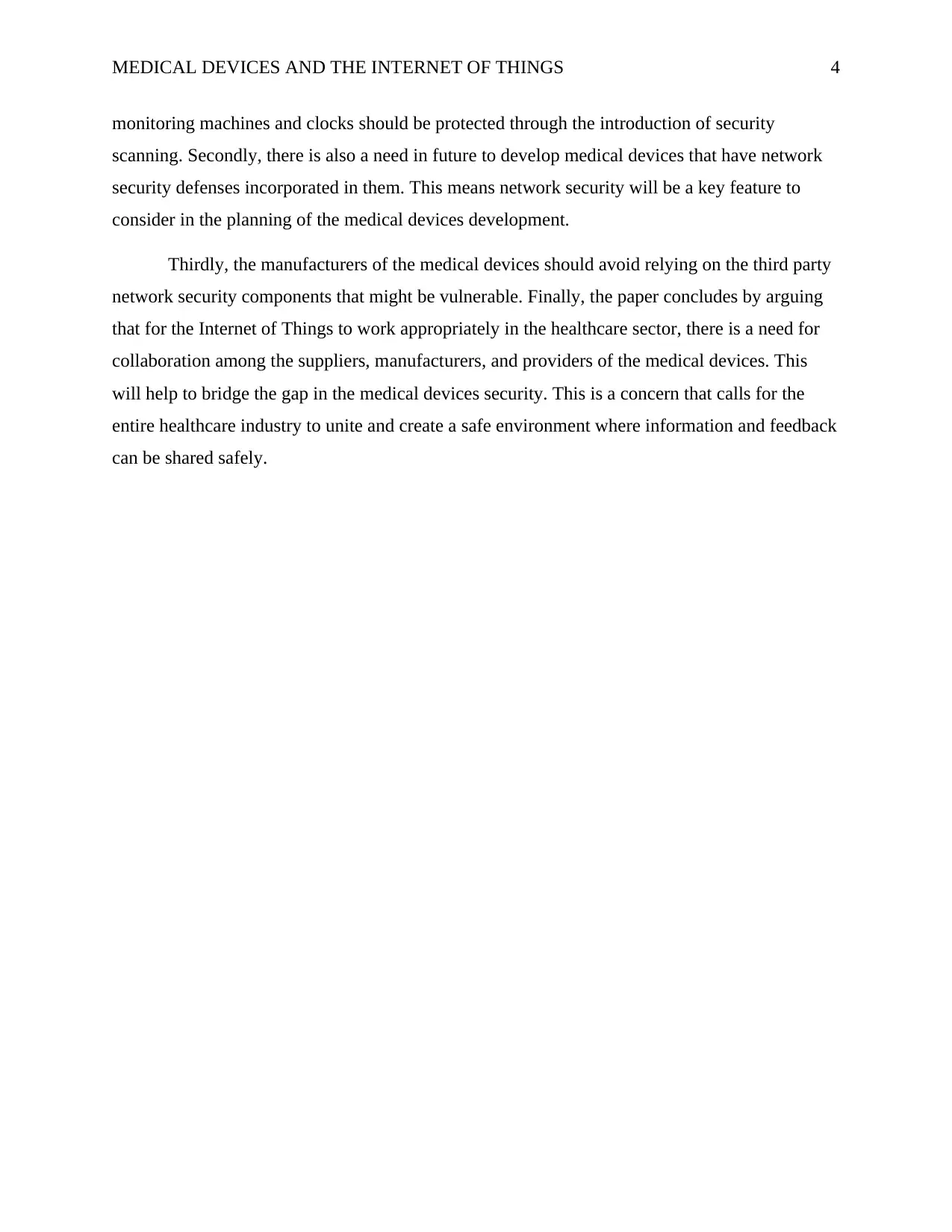
MEDICAL DEVICES AND THE INTERNET OF THINGS 4
monitoring machines and clocks should be protected through the introduction of security
scanning. Secondly, there is also a need in future to develop medical devices that have network
security defenses incorporated in them. This means network security will be a key feature to
consider in the planning of the medical devices development.
Thirdly, the manufacturers of the medical devices should avoid relying on the third party
network security components that might be vulnerable. Finally, the paper concludes by arguing
that for the Internet of Things to work appropriately in the healthcare sector, there is a need for
collaboration among the suppliers, manufacturers, and providers of the medical devices. This
will help to bridge the gap in the medical devices security. This is a concern that calls for the
entire healthcare industry to unite and create a safe environment where information and feedback
can be shared safely.
monitoring machines and clocks should be protected through the introduction of security
scanning. Secondly, there is also a need in future to develop medical devices that have network
security defenses incorporated in them. This means network security will be a key feature to
consider in the planning of the medical devices development.
Thirdly, the manufacturers of the medical devices should avoid relying on the third party
network security components that might be vulnerable. Finally, the paper concludes by arguing
that for the Internet of Things to work appropriately in the healthcare sector, there is a need for
collaboration among the suppliers, manufacturers, and providers of the medical devices. This
will help to bridge the gap in the medical devices security. This is a concern that calls for the
entire healthcare industry to unite and create a safe environment where information and feedback
can be shared safely.
Paraphrase This Document
Need a fresh take? Get an instant paraphrase of this document with our AI Paraphraser
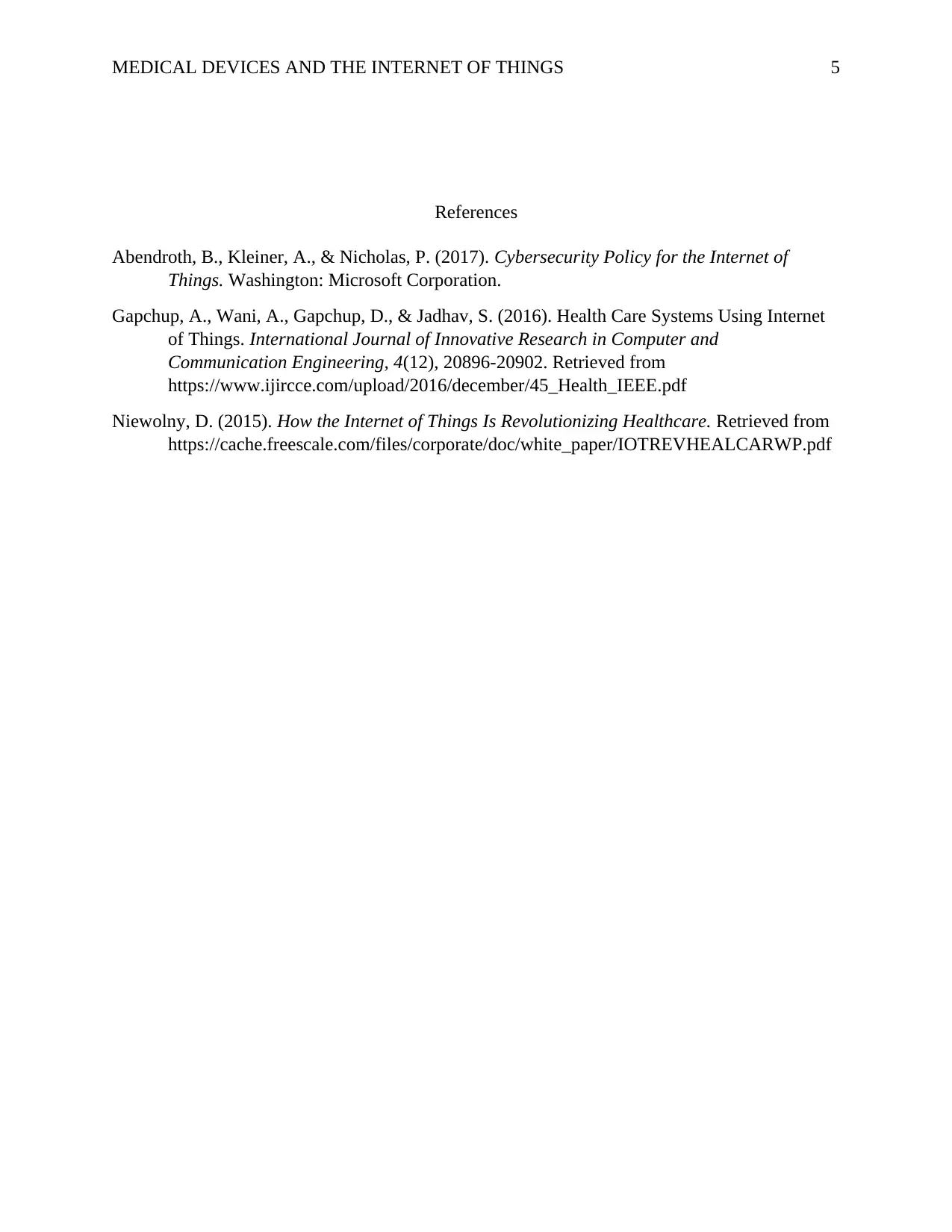
MEDICAL DEVICES AND THE INTERNET OF THINGS 5
References
Abendroth, B., Kleiner, A., & Nicholas, P. (2017). Cybersecurity Policy for the Internet of
Things. Washington: Microsoft Corporation.
Gapchup, A., Wani, A., Gapchup, D., & Jadhav, S. (2016). Health Care Systems Using Internet
of Things. International Journal of Innovative Research in Computer and
Communication Engineering, 4(12), 20896-20902. Retrieved from
https://www.ijircce.com/upload/2016/december/45_Health_IEEE.pdf
Niewolny, D. (2015). How the Internet of Things Is Revolutionizing Healthcare. Retrieved from
https://cache.freescale.com/files/corporate/doc/white_paper/IOTREVHEALCARWP.pdf
References
Abendroth, B., Kleiner, A., & Nicholas, P. (2017). Cybersecurity Policy for the Internet of
Things. Washington: Microsoft Corporation.
Gapchup, A., Wani, A., Gapchup, D., & Jadhav, S. (2016). Health Care Systems Using Internet
of Things. International Journal of Innovative Research in Computer and
Communication Engineering, 4(12), 20896-20902. Retrieved from
https://www.ijircce.com/upload/2016/december/45_Health_IEEE.pdf
Niewolny, D. (2015). How the Internet of Things Is Revolutionizing Healthcare. Retrieved from
https://cache.freescale.com/files/corporate/doc/white_paper/IOTREVHEALCARWP.pdf
1 out of 5
Related Documents
Your All-in-One AI-Powered Toolkit for Academic Success.
+13062052269
info@desklib.com
Available 24*7 on WhatsApp / Email
![[object Object]](/_next/static/media/star-bottom.7253800d.svg)
Unlock your academic potential
Copyright © 2020–2025 A2Z Services. All Rights Reserved. Developed and managed by ZUCOL.




